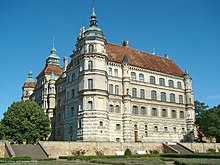Mecklenburg-Guestrow
Mecklenburg-Güstrow refers to the former partial duchy of Mecklenburg-Güstrow, which later formed the Wendish district in the part (large) duchy of Mecklenburg-Schwerin .
history
The partial duchy of Mecklenburg-Güstrow was created in the course of the second main division of Mecklenburg according to the Fahrholz partition treaty in 1621 through the real division of the territory of the Dukes of Mecklenburg . A division of power from Mecklenburg into a Schwerin and a Güstrow region - named after the main residence - already existed with a few interruptions after the death of Heinrich the Dicken in 1477 and again from 1520 after the Neubrandenburg house contract . This laid down the division of the country into the parts of Schwerin and Güstrow, which was forced by his son Albrecht VII after the death of Magnus II . The Schwerin area traditionally claimed the western, the Güstrower the eastern parts of the lands belonging to the Mecklenburg territory.
During the division of 1621 between Adolf Friedrich I and Johann Albrecht II , the latter received the offices of Güstrow, Ribnitz, Schwaan, Dargun, Gnoien, Neukalen, Plau, Stargard, Stavenhagen, Boitzenburg, Broda, Feldberg, Fürstenberg, Goldberg, Ivenack, Strelitz, Wanzka, Wesenberg and Wredenhagen, as well as the cities Friedland, Krakow, Laage, Malchin, Marlow, Neubrandenburg, Penzlin, Röbel, Sülze, Teterow and Woldegk. The city of Rostock with Warnemünde, the four state monasteries Dobbertin, Malchow, Ribnitz and the monastery of the Holy Cross in Rostock remained common property .
At the insistence of the united states , the court and regional courts, the consistory, the state parliament, the decision on border disputes and the costs to the Reich Chamber of Commerce remained together.
This division of power was not recognized under imperial or feudal law. Logically, both rulers of the resulting partial rule continued to name the dukes of Mecklenburg unchanged and without distinction. The name of the partial rulers was added to this title to make it easier to differentiate.
The residence of the Güstrow part of the country was the Vorderstadt Güstrow until 1695 . After the Obodritischen ruling dynasty was temporarily expelled, Albrecht von Wallenstein resided as Mecklenburg Duke in Güstrow Castle from 1628 to 1630 .
In 1631, after Wallenstein's fall, Duke Johann Albrecht , who had fled Güstrow, moved back into his Güstrow residence.
With the death of his son Gustav Adolf (1695), the Mecklenburg-Güstrow line of the dynasty died out in the second generation of the male line capable of following the throne. Profound legal uncertainties then led to an inheritance dispute lasting several years in the Mecklenburg Princely House, which at times assumed a warlike character and could ultimately only be settled through the influence of the emperor and foreign powers of the Lower Saxony Empire .
After many years of negotiations was on March 8, 1701 Hamburg between the Dukes (I.) Frederick William as Regent of Mecklenburg-Schwerin and Adolf Friedrich (II.) As a future ruler of the newly formed (partial) Duchy of Mecklenburg-Strelitz agreement achieved to the effect that the Güstrow legacy should be divided between the two in terms of value ( Hamburg comparison ). The Schwerin Duke was formally assigned the (partial) duchy of Mecklenburg-Güstrow with the vote attached to the Reichstag (but without the areas assigned to Strelitz). As a result, the name Mecklenburg-Güstrow was retained in legal documents until the end of the Old Kingdom. In the state constitution of Mecklenburg it even existed until 1918. The larger part of Mecklenburg-Güstrow that remained with the (partial) Grand Duchy of Mecklenburg-Schwerin formed the so-called Wendish district of the Mecklenburg state as a whole.
Regents
| Reign | Surname | ancestry |
|---|---|---|
1520–1547
|
Albrecht VII , the Handsome , Duke of Mecklenburg (1503–1547) | Son of Magnus II. |
1547–1555
|
Johann Albrecht I , Duke of Mecklenburg (1525–1576) | Son of Albrecht VII. |
1555–1603
|
Ulrich , Duke of Mecklenburg (1527–1603) | Son of Albrecht VII. |
1603–1610
|
Charles I , Duke of Mecklenburg (1540–1610) | Son of Albrecht VII. |
1611–1628
|
Johann Albrecht II. (Hans Albrecht), Duke of Mecklenburg (1590–1636) | Son of John VII. |
(1628–1631)
|
Albrecht von Wallenstein (1583–1634) | |
1631–1636
|
Johann Albrecht II (again) | |
1636–1695
|
Gustav Adolf , Duke of Mecklenburg (1636–1695) | Son of Johann Albrechts II. |
(1695–1701)
|
vacancy |
See also
literature
- Ilka Minneker: From the monastery to the residence. Dynastic memoria and representation in late medieval and early modern Mecklenburg . Rhema-Verlag, Münster 2007. ISBN 978-3-930454-78-5
- Gustav Duncker: The second Mecklenburg main division. In: Yearbooks of the Association for Mecklenburg History and Archeology. Schwerin 73 (1908), pp. 177–292 ( digital and full text )
Footnotes
- ↑ Since 1608 under the tutelage of Karl I .; succeded on July 9, 1611 [WIGGER, Stammtafeln (1885), p. 312], according to other sources as early as 1610 after the death of Charles I on July 22, 1610
- ↑ Until 1654 under the tutelage of Adolf Friedrich I (1588–1658)

